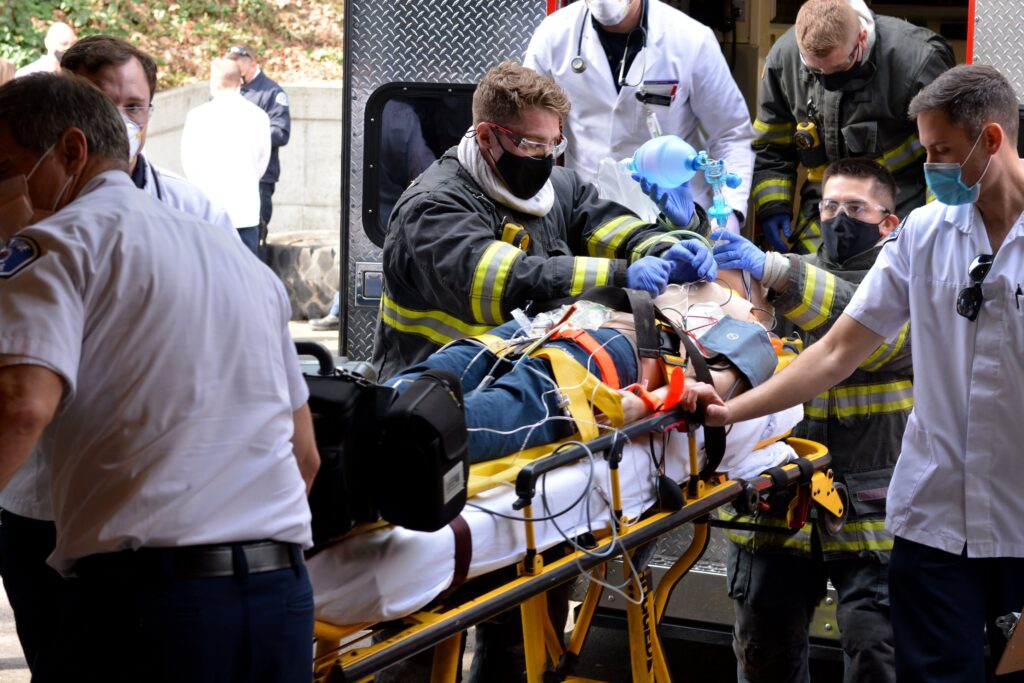
Trauma Assessment: DCAP-BTLS Acronym
DCAP-BTLS Trauma Assessment for EMS Providers
Table of Contents
- Overview of the Trauma Assessment
- D – Deformities
- C – Contusions
- A – Abrasions
- P – Punctures/Penetrations
- B – Burns
- T – Tenderness
- L – Lacerations
- S – Swelling
- Conclusion
Overview of the Trauma Assessment
This trauma assessment conducted by Emergency Medical Service providers utilizes a systematic approach to evaluate patients for life-threatening and potentially life-altering injuries. Initially assessing the patient’s airway, breathing and circulation, the EMS provider then performs a thorough head-to-toe secondary survey to identify less obvious trauma. The DCAP-BTLS mnemonic serves as an aide memoir to guide EMS providers in methodically inspecting the integumentary, musculoskeletal and neurological systems for deformities, contusions, abrasions, puncture wounds, burns, tenderness, lacerations and swelling which could indicate injuries requiring rapid stabilization and transport to definitive care. A structured evaluation using this acronym helps to ensure no trauma is overlooked and the patient receives timely treatment for their dermal, soft tissue and osseous injuries.
D – Deformities
Any abnormality in the shape or form of a body part should be noted during the trauma assessment. The EMS provider will carefully inspect the patient’s limbs, spine and skull for deformities such as angulation, shortening, rotation or swelling which could indicate fractures.
C – Contusions
Commonly known as bruises, contusions are injuries characterized by bleeding into the subcutaneous tissue. The EMS provider will palpate the patient’s skin looking for areas of discoloration, edema and tenderness indicative of contusions which could suggest deeper tissue injuries.
A – Abrasions
These are superficial injuries where the epidermis or outermost layer of skin is scraped off. The EMS provider will inspect the patient for open wounds with abrasions of the skin which expose dermal layers. These can become infected if foreign bodies are embedded.
P – Punctures/Penetrations
Injuries where an object has pierced the skin, creating an open wound. The EMS provider must determine if the penetrating object remains in the wound and stabilize it if so to avoid further tissue damage. Bleeding and infection risks are high with penetrating trauma.
B – Burns
Injuries to the skin and sometimes deeper tissues caused by heat, chemicals, electricity or radiation. The EMS provider will classify burns by depth and percentage of total body surface area involved to determine severity and fluid resuscitation needs.
T – Tenderness
Pain response elicited upon palpation of an injured area. The EMS provider will palpate bony prominences and soft tissue to detect areas of tenderness which could indicate serious injuries such as fractures, muscle tears or internal organ damage.
L – Lacerations
A cut or tear in soft tissue, often the skin, caused by shearing forces. The EMS provider will clean and dress open lacerations to reduce risk of infection, control bleeding and stabilize the wound until definitive care.
S – Swelling
Abnormal accumulation of fluid in the interstitial spaces of the tissue. The EMS provider will measure circumference of swollen areas before and after splinting to monitor for worsening edema which could indicate compartment syndrome.
Conclusion
Utilizing the DCAP-BTLS acronym during the secondary trauma survey allows EMS providers to conduct a thorough evaluation of the integumentary, musculoskeletal and neurological systems for injuries that could be life-altering if left unrecognized. By meticulously inspecting for deformities, contusions, abrasions, puncture wounds, burns, areas of tenderness, lacerations and swelling, emergency medical technicians and paramedics can more readily identify fractures, soft tissue injuries, neurological deficits and other trauma requiring prompt management to mitigate risks like hemorrhage, infection and further tissue damage. Implementing this systematic approach during each trauma call has the potential to enhance completeness of assessments, reduce oversights and hasten delivery of stabilizing interventions that improve patient outcomes. While one tool among others, EMS providers must receive rigorous training that emphasizes adhering to structured evaluation protocols during the trauma assessment in order to optimize care for patients suffering dermal, soft tissue and musculoskeletal trauma. With diligent application of the DCAP-BTLS acronym and other systematic techniques, emergency medical services can make meaningful strides toward delivering the highest quality, most compassionate care for patients in their time of greatest need.
Stay Response Ready.
Click the link below for more:
https://responsereadymedical.com/blog/
Stay Response Ready.
